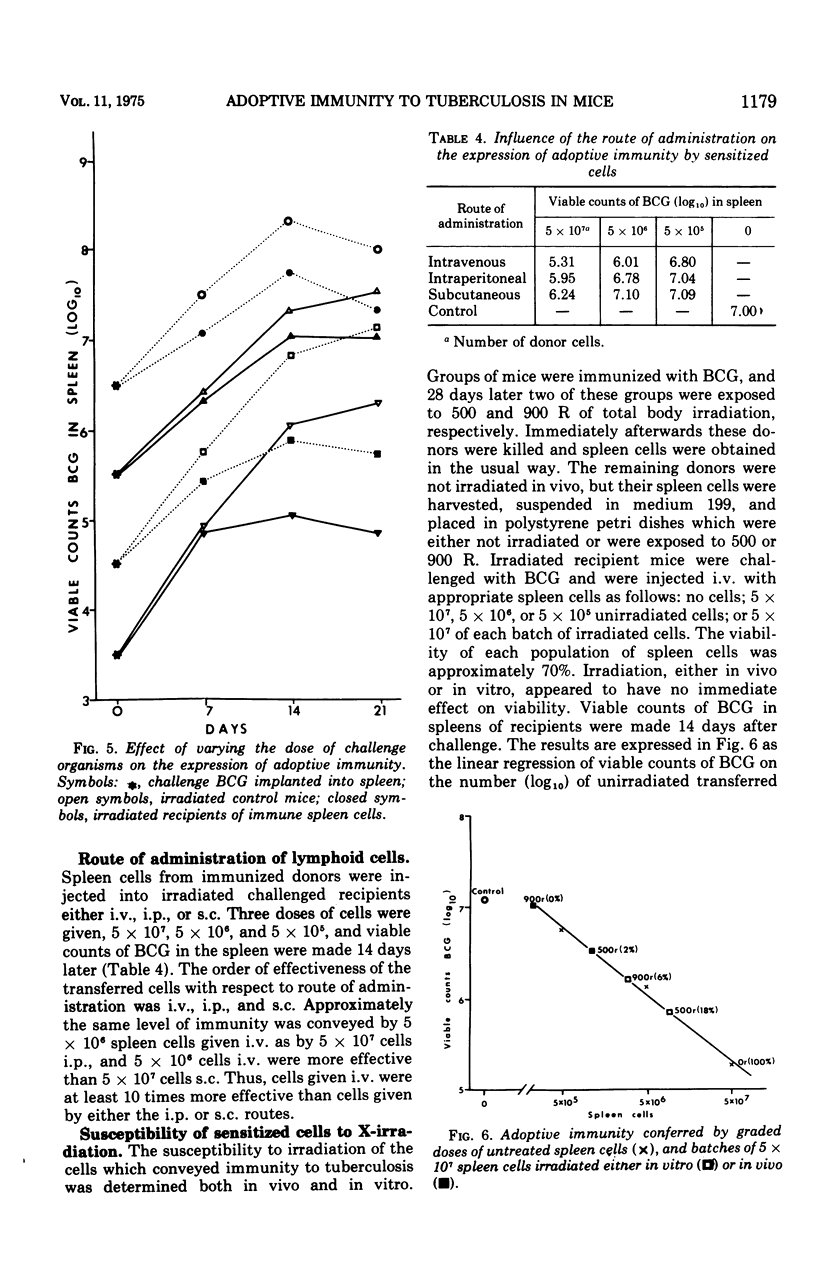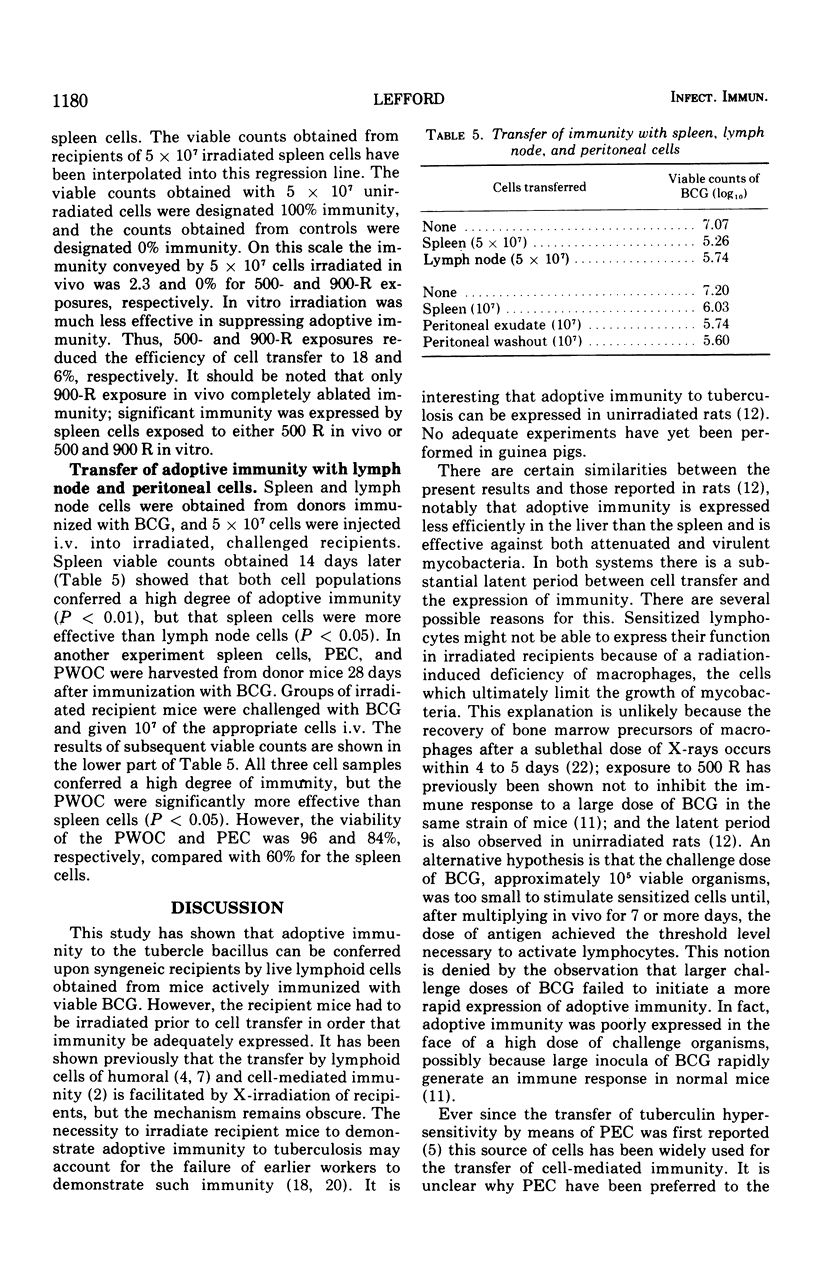Abstract
A system is described for studying adoptive immunity to tuberculosis in syngeneic mice. Donor mice were immunized with 104 BCG intravenously, and lymphoid cells were harvested 28 days later. Adoptive immunity was measured in recipient mice in terms of the inhibition of growth of BCG in the liver and spleen following intravenous injection. Adoptive immunity was expressed optimally when recipients were sublethally irradiated (500 R), challenged with 104 to 105 viable organisms, and given sensitized lymphoid cells intravenously. Adoptive immunity was not manifest until 14 days after challenge and was effective against Mycobacterium tuberculosis H37Rv as well as BCG. Immunity could be conferred by spleen, lymph node, peritoneal exudate, and resident peritoneal (washout) cells. The lymphoid cells conferring immunity were shown to be thymus-dependent lymphocytes by virtue of their nonadherence to glass wool and sensitivity to anti-θ serum plus complement. The sensitized cells were relatively susceptible to both in vitro and in vivo X-irradiation.
Full text
PDF







Selected References
These references are in PubMed. This may not be the complete list of references from this article.
- ARNASON B. G., JANKOVIC B. D., WAKSMAN B. H., WENNERSTEN C. Role of the thymus in immune reactions in rats. II. Suppressive effect of thymectomy at birth on reactions of delayed (cellular) hypersensitivity and the circulating small lymphocyte. J Exp Med. 1962 Aug 1;116:177–186. doi: 10.1084/jem.116.2.177. [DOI] [PMC free article] [PubMed] [Google Scholar]
- Asherson G. L., Zembala M. Contact sensitivity in the mouse. IV. The role of lymphocytes and macrophages in passive transfer and the mechanism of their interaction. J Exp Med. 1970 Jul 1;132(1):1–15. doi: 10.1084/jem.132.1.1. [DOI] [PMC free article] [PubMed] [Google Scholar]
- Bloom B. R., Chase M. W. Transfer of delayed-type hypersensitivity. A critical review and experimental study in the guinea pig. Prog Allergy. 1967;10:151–255. [PubMed] [Google Scholar]
- Celada F. Quantitative studies of the adoptive immunological memory in mice. I. An age-dependent barrier to syngeneic transplantation. J Exp Med. 1966 Jul 1;124(1):1–14. doi: 10.1084/jem.124.1.1. [DOI] [PMC free article] [PubMed] [Google Scholar]
- Cohen A., Schlesinger M. Absorption of guinea pig serum with agar. A method for elimination of itscytotoxicity for murine thymus cells. Transplantation. 1970 Jul;10(1):130–132. doi: 10.1097/00007890-197007000-00027. [DOI] [PubMed] [Google Scholar]
- DRESSER D. W. A study of the adoptive secondary response to a protein antigen in mice. Proc R Soc Lond B Biol Sci. 1961 Jul 25;154:398–417. doi: 10.1098/rspb.1961.0039. [DOI] [PubMed] [Google Scholar]
- FONG J., CHIN D., ELBERG S. S. Studies on tubercle bacillus-histiocyte relationship. V. Passive transfer of cellular resistance. J Exp Med. 1962 Mar 1;115:475–489. doi: 10.1084/jem.115.3.475. [DOI] [PMC free article] [PubMed] [Google Scholar]
- Feldman J. D. The role of proliferation in delayed hypersensitivity. J Immunol. 1968 Sep;101(3):563–571. [PubMed] [Google Scholar]
- Koster F. T., McGregor D. D. The mediator of cellular immunity. 3. Lymphocyte traffic from the blood into the inflamed peritoneal cavity. J Exp Med. 1971 Apr 1;133(4):864–876. doi: 10.1084/jem.133.4.864. [DOI] [PMC free article] [PubMed] [Google Scholar]
- Lefford M. J., McGregor D. D., Mackaness G. B. Immune response to Mycobacterium tuberculosis in rats. Infect Immun. 1973 Aug;8(2):182–189. doi: 10.1128/iai.8.2.182-189.1973. [DOI] [PMC free article] [PubMed] [Google Scholar]
- Lefford M. J., McGregor D. D., Mackaness G. B. Properties of lymphocytes which confer adoptive immunity to tuberculosis in rats. Immunology. 1973 Oct;25(4):703–715. [PMC free article] [PubMed] [Google Scholar]
- Lefford M. J. The effect of inoculum size on the immune response to BCG infection in mice. Immunology. 1971 Aug;21(2):369–381. [PMC free article] [PubMed] [Google Scholar]
- MILLMAN I. Passive transfer of resistance to tuberculosis. Am Rev Respir Dis. 1962 Jan;85:30–32. doi: 10.1164/arrd.1962.85.1.30. [DOI] [PubMed] [Google Scholar]
- McGregor D. D., Logie P. S. The mediator of cellular immunity. VII. Localization of sensitized lymphocytes in inflammatory exudates. J Exp Med. 1974 Jun 1;139(6):1415–1430. doi: 10.1084/jem.139.6.1415. [DOI] [PMC free article] [PubMed] [Google Scholar]
- North R. J. Importance of thymus-derived lymphocytes in cell-mediated immunity to infection. Cell Immunol. 1973 Apr;7(1):166–176. doi: 10.1016/0008-8749(73)90193-7. [DOI] [PubMed] [Google Scholar]
- SEVER J. L. Passive transfer of resistance to tuberculosis through use of monocytes. Proc Soc Exp Biol Med. 1960 Feb;103:326–329. doi: 10.3181/00379727-103-25506. [DOI] [PubMed] [Google Scholar]
- Takeya K., Mori R., Nomoto K., Nakayama H. Experimental mycobacterial infections in neonatally thymectomized mice. Am Rev Respir Dis. 1967 Sep;96(3):469–477. doi: 10.1164/arrd.1967.96.3.469. [DOI] [PubMed] [Google Scholar]
- Volkman A., Collins F. M. Recovery of delayed-type hypersensitivity in mice following suppressive doses of X-radiation. J Immunol. 1968 Nov;101(5):846–859. [PubMed] [Google Scholar]


